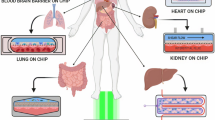Abstract
This study introduces a novel design for a microfluidic element used in a high-throughput screening mass spectrometer autosampler. The original design of the sampler consists of a liquid bridge formed in a micrometer gap between two capillaries. This liquid bridge is used to receive the sample, which is later ionized and analyzed by mass spectrometry. However, this liquid bridge is difficult to establish and maintain for long time periods, making the screening of large libraries of compounds a tedious task. The improvement described here consists in replacing the liquid bridge by a single pierced capillary, called “semi-open capillary”. The fabrication of semi-open capillaries is explained. To achieve an optimum structure, two different machining methods were tested, laser ablation and electro-discharge micromachining. The advantages of this design over the previous one include reduction of the dead volume and that of the sample dilution, as well as higher stability. Characterizations of the repeatability and the limit of detection (LOD) show that the optimized semi-open capillary leads to nearly twofold lower LOD when compared to the original liquid bridge.
Graphical Abstract








Similar content being viewed by others
References
Bleicher KH, Böhm H-J, Müller K, Alanine AI (2003) Hit and lead generation: beyond high-throughput screening. Nat Rev Drug Discov 2:369–378
Chen H, Talaty NN, Takáts Z, Cooks RG (2005) Desorption electrospray ionization mass spectrometry for high-throughput analysis of pharmaceutical samples in the ambient environment. Anal Chem 77:6915–6927
Chen YG, Kowtoniuk WE, Agarwal I, Shen Y, Liu DR (2009) LC/MS analysis of cellular RNA reveals NAD-linked RNA. Nat Chem Biol 5:879–881
Chen Q, Wu J, Zhang Y, Lin J-M (2012) Qualitative and quantitative analysis of tumor cell metabolism via stable isotope labeling assisted microfluidic chip electrospray ionization mass spectrometry. Anal Chem 84:1695–1701
Chu Y-H, Dunayevskiy YM, Kirby DP, Vouros P, Karger BL (1996) Affinity capillary electrophoresis—mass spectrometry for screening combinatorial libraries. J Am Chem Soc 118:7827–7835
Drug discovery market worldwide by segment 2025 forecast|Statistic. Statista. https://www.statista.com/statistics/765535/drug-discovery-market-worldwide-by-segment-globally/. Accessed 21 June 2018
Ducrée J et al (2007) The centrifugal microfluidic Bio-Disk platform. J Micromec Microeng 17:S103
Fiehn O et al (2000) Metabolite profiling for plant functional genomics. Nat Biotechnol 18:1157–1161
Ghiasikhou S, Fabricio da Silva M, Zhu Y, Zenobi R (2017) The capillary gap sampler, a new microfluidic platform for direct coupling of automated solid-phase microextraction with ESI-MS. Anal Bioanal Chem 409:6873–6883
Gorkin R et al (2010) Centrifugal microfluidics for biomedical applications. Lab Chip 10:1758–1773
How Sinker EDM Machining Works. http://www.edmmachining.com/sinker_edm.htm. Accessed: 28 June 2018
Jian W et al (2011) Evaluation of a high-throughput online solid phase extraction-tandem mass spectrometry system for in vivo bioanalytical studies. Anal Chem 83:8259–8266
Jin D-Q, Zhu Y, Fang Q (2014) Swan probe: a nanoliter-scale and high-throughput sampling interface for coupling electrospray ionization mass spectrometry with microfluidic droplet array and multiwell plate. Anal Chem 86:10796–10803
Keller M, Naue J, Zengerle R, von Stetten F, Schmidt U (2015) Automated forensic animal family identification by nested PCR and melt curve analysis on an off-the-shelf thermocycler augmented with a centrifugal microfluidic disk segment. PLoS ONE 10:e0131845
Laser ablation (2018) Wikipedia
Ma H, Horiuchi KY, Wang Y, Kucharewicz SA, Diamond SL (2005) Nanoliter homogenous ultra-high throughput screening microarray for lead discoveries and IC50 profiling. Assay Drug Dev Technol 3:177–187
Mao S, Zhang J, Li H, Lin J-M (2013) Strategy for signaling molecule detection by using an integrated microfluidic device coupled with mass spectrometry to study cell-to-cell communication. Anal Chem 85:868–876
Neu V, Steiner R, Müller S, Fattinger C, Zenobi R (2013) Development and characterization of a capillary gap sampler as new microfluidic device for fast and direct analysis of low sample amounts by ESI-MS. Anal Chem 85:4628–4635
Neu V, Dörig P, Fattinger C, Müller S, Zenobi R (2016) Characterization of a miniaturized liquid bridge for nL sample infusion: a comparative study of sample flush-out behavior using flow simulations and direct ESI-MS analysis. Microfluid Nanofluidics 20:62
Ozbal CC et al (2004) High throughput screening via mass spectrometry: a case study using acetylcholinesterase. Assay Drug Dev Technol 2:373–381
Rodenstein M, Zürcher S, Tosatti SGP, Spencer ND (2010) Fabricating chemical gradients on oxide surfaces by means of fluorinated, catechol-based, self-assembled monolayers. Langmuir 26:16211–16220
Sreekumar A et al (2009) Metabolomic profiles delineate potential role for sarcosine in prostate cancer progression. Nature 457:910–914
Stark T, Wollmann N, Lösch S, Hofmann T (2011) Quantitation of resveratrol in red wines by means of stable isotope dilution analysis—ultra-performance liquid chromatography—quan-time-of-flight mass spectrometry and cross validation. Anal Chem 83:3398–3405
Strohmeier O et al (2015) Automated nucleic acid extraction from whole blood, B. subtilis, E. coli, and Rift Valley fever virus on a centrifugal microfluidic LabDisk. RSC Adv 5:32144–32150
Sun S, Kennedy RT (2014) Droplet electrospray ionization mass spectrometry for high throughput screening for enzyme inhibitors. Anal Chem 86:9309–9314
van Reenen A, de Jong AM, den Toonder JMJ, Prins MWJ (2014) Integrated lab-on-chip biosensing systems based on magnetic particle actuation—a comprehensive review. Lab Chip 14:1966–1986
Wan H et al (2003) High-throughput screening of pKa values of pharmaceuticals by pressure-assisted capillary electrophoresis and mass spectrometry. Rapid Commun Mass Spectrom 17:2639–2648
Wohlfarth C (2008) Surface tension of pure liquids and binary liquid mixtures: (supplement to IV/16). Springer, Berlin
Zhang S, Pelt CKV (2004) Chip-based nanoelectrospray mass spectrometry for protein characterization. Expert Rev. Proteomics 1:449–468
Acknowledgements
We gratefully thank Dr. Christof Fattinger (Roche) for his support in sampler development and Professor Ying Zhu (Department Chemistry, Zhejiang University) for helping in optimizing the structure of the hole. Moreover, we thank the Scientific Center for Optical and Electron Microscopy (ScopeM), a central technology platform of ETH Zurich, for providing us with resources and services in electron microscopy, the ETH Physics workshop for performing EDM for semi-open capillary preparation, and the SuSoS company in Dübendorf for providing us with a PFAND solution and for recording XPS data. Finally, we thank the Swiss National Science Foundation (SNSF) for funding this project (Grant Nos. 200020-159929 & 200020-178765).
Author information
Authors and Affiliations
Corresponding author
Additional information
Publisher's Note
Springer Nature remains neutral with regard to jurisdictional claims in published maps and institutional affiliations.
Electronic supplementary material
Below is the link to the electronic supplementary material.
Rights and permissions
About this article
Cite this article
Ghiasikhou, S., Marchand, A. & Zenobi, R. A comparative study between a miniaturized liquid junction built in a capillary gap and semi-open capillaries for nL sample infusion to mass spectrometry. Microfluid Nanofluid 23, 60 (2019). https://doi.org/10.1007/s10404-019-2229-7
Received:
Accepted:
Published:
DOI: https://doi.org/10.1007/s10404-019-2229-7




